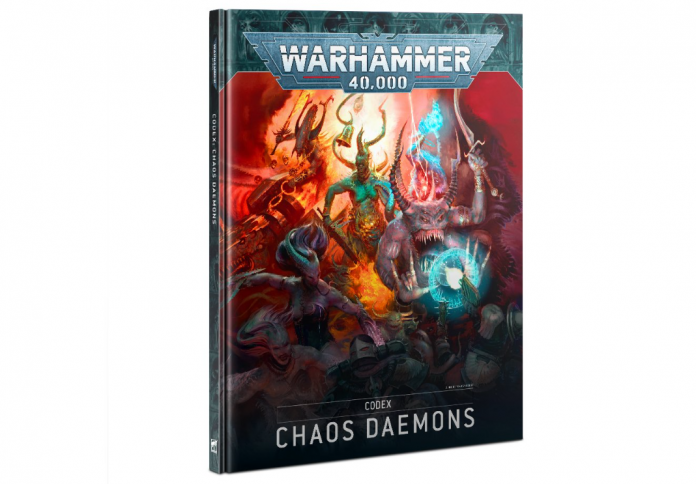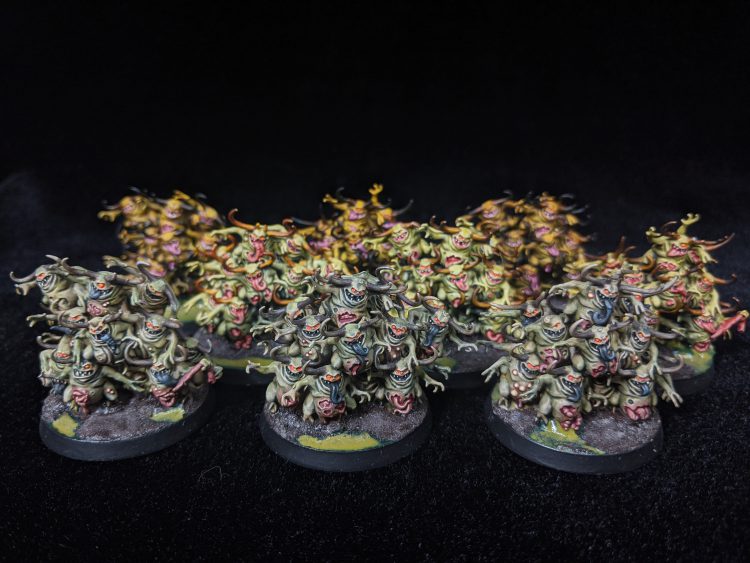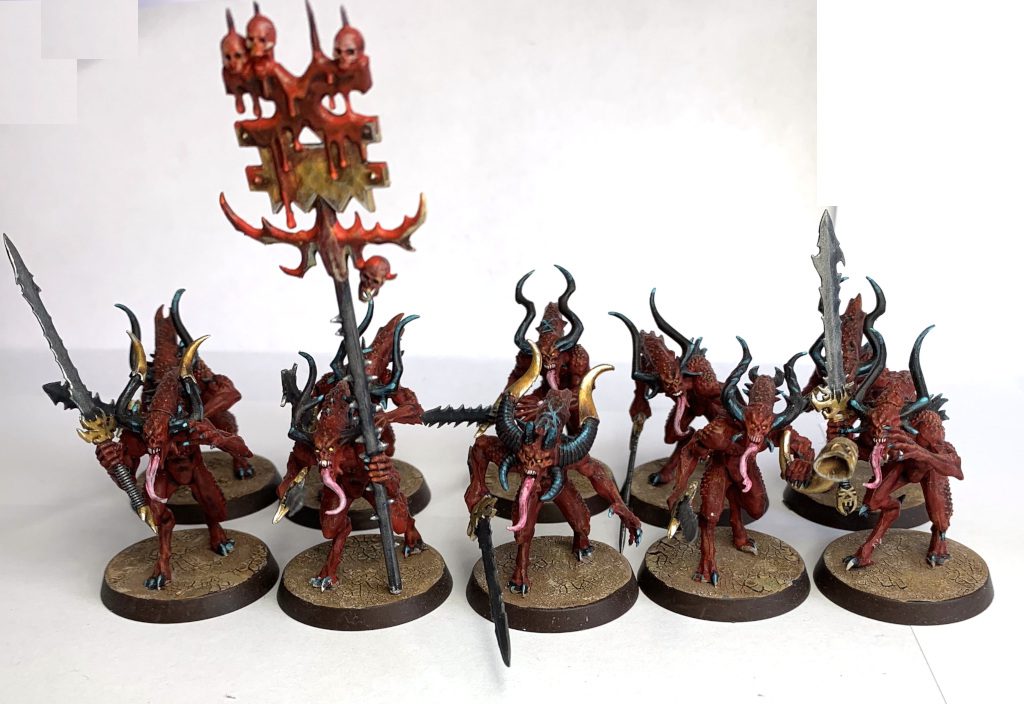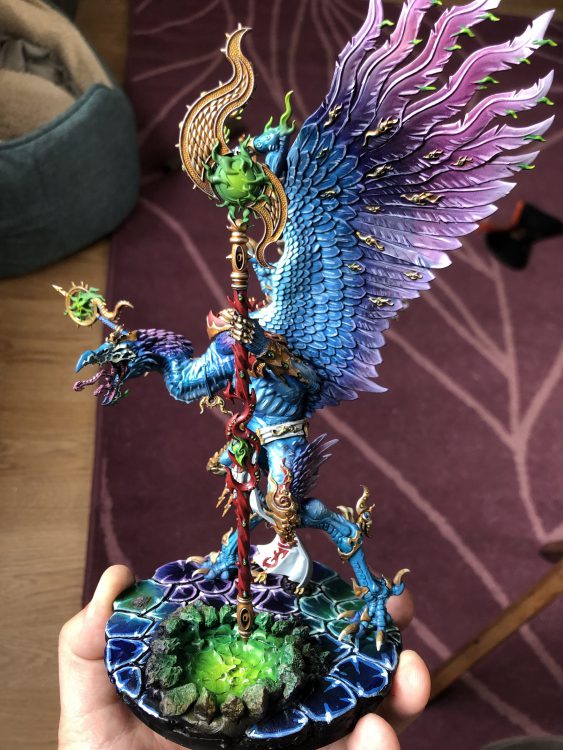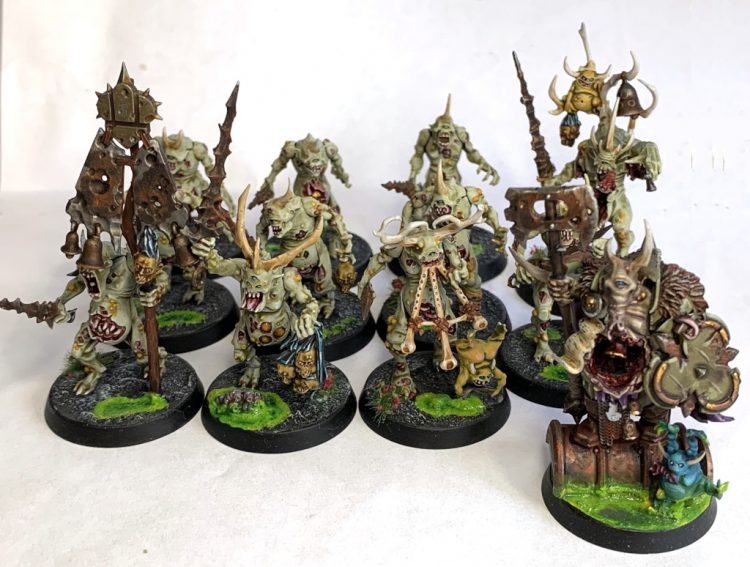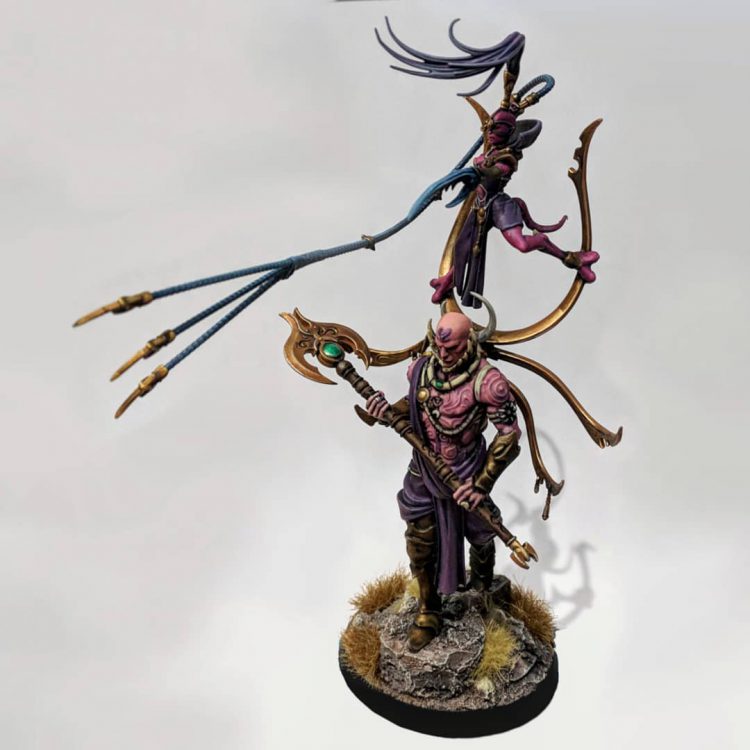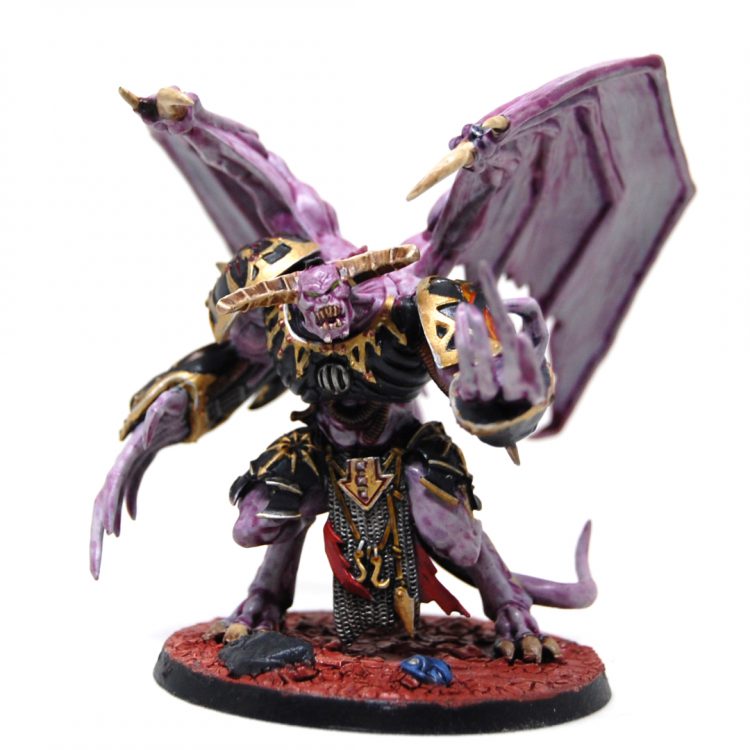Our long march through the 9th edition codex release schedule seems to be nearing its end as Games Workshop sets up for their next release, Codex: Chaos Daemons. Daemons have had an up-and-down relationship with 9th edition; they started off incredibly strong before the release of Drukhari, but over the last year and a half have fallen off hard as their rules have continually shown their age more and more – right now Daemons are the only faction in the game incapable of getting a second warlord trait. So if you’re a daemons player, rejoice – the long wait is finally over. But was the wait worth it?
Before we dive in, we’d like to thank Games Workshop for providing us with a preview copy of the book for review purposes.
We’re also joined today by Michael Pestilens, known Daemons expert and creator/author of Warphammer.
Why Play Chaos Daemons?
The ruinous powers of the four Chaos Gods don’t rely on mortals for everything – they’ve got their own legions of daemonic servants, frightening entities who invade realspace to wreak havoc on the mortal realms. Because they lack guns and similar technology, daemons tend to focus more on melee combat and psychic powers (though they aren’t completely helpless with ranged attacks – many can throw fire or spit all manner of foulness). And while they can be a standalone force, they also work well with Chaos Space Marines – you can supplement your mortal forces with daemonic legions for a fluffy force that can shore up the weaknesses of each army… at a cost.
What’s in this Book?
- Rules for playing with Chaos Daemons, both standalone armies and as allies to other Chaos forces
- Datasheets for Daemon units of every god, plus three which are unaligned
- Relics, Warlord Traits, and Psychic powers for the minions of each of the Chaos Gods
- Crusade rules for participating in the Great Game between the Chaos Gods, and earning the rewards that come from it
- An updated Army of Renown for Be’lakor which allows you to combine Daemons, Chaos Space Marines, and Chaos Knights under the banner of the Dark Prince
Where’s Crusade?
The Crusade rules in this book are really cool, and as usual we’ll be covering them on Tuesday – so stay tuned!
The Five Best Things About This Book
- Manifestation Rules: Summoning is gone but in its place Daemons get the ability to be put into reserves and then deep strike onto the battlefield. The upside here is that they can be closer than 9” to an enemy, particularly if you’re in your own deployment zone, within 6” of a WARP LOCUS, or trying to drop in No Man’s Land near an enemy with a lower Leadership value.
- Daemonic Allies: Similar to the rules for Harlequins, if you take a Daemons detachment which has a total Power Level less than 25% of your army’s total, the entire detachment gains the AGENTS OF CHAOS keyword and doesn’t affect your army-wide rules or secondary objectives.
- Datasheet Updates: Some of the datasheets you’d have never considered with the old codex are now pretty damn good – Slaanesh Chariots, Soul Grinders, and Screamers all have cool things going on, and some of the better old datasheets are now also pretty bonkers – Beasts of Nurgle and Flamers look real nasty.
- Updated Rules: Just having a 9th edition book is a big deal for Chaos Daemons, who can now pay points for Exalted Daemon upgrades (instead of CP), and the combat profiles of daemons are now much more menacing when compared to the likes of Drukhari and Possessed.
- Crusade: Not only are the Crusade rules in this book straight fire, this is also the first (and only) book to put the Crusade rules after the datasheets, so you won’t have to page through them every time you need to go from the datasheets to your army rules. Huzzah!
The Rules
Daemons have always been one of the more out there books, and they come with a host of special armywide rules to represent their immaterial nature.
Detachment Rules
Legiones Daemonica detachments (detachments that contain only codex Daemons units, with the exception of Unaligned and Agents Of Chaos units) all gain pretty standard rules.
Let’s talk first about what is most glaringly not in the detachment rules: A cap on Greater Daemons. This is a huge relief to everyone that owned two or more Keepers Of Secrets, Bloodthirsters, Great Unclean Ones, and Lords of Change. You can continue to run as many Greater Daemons (and Be’lakor!) as you can fit in a list. Note that this is now harder in some ways due to huge price hikes on the Troops you need for extra detachments and the Greater Daemons themselves, but that’s still a direction you can absolutely explore with your lists. One of your Greater Daemons or Be’lakor must be the Warlord if you include them in your list, which is perfectly fine with you.
Your Troops all gain ObSec, but with one catch: Swarm units don’t benefit from this rule. That means no ObSec for all of our lovable little Nurglings. Nurglings are still a fine unit because of other benefits they provide, so don’t fret just yet.
Also unsurprisingly if you’ve followed other 9th Edition trends, you can include 1 Herald without taking up an HQ slot for every Greater Daemon in your detachment. Extra HQ slots are never a bad thing to have.
Daemonic Allies
This is one of the biggest deals in the entire book. The big one here is the Daemonic Pact rule, which says that if your army includes one LEGIONES DAEMONIC Deatachment, and the combined power ratings of all the units in that Detachment make up no more than 25% of your army’s Power Level, then every unit in that detachment gains the AGENT OF CHAOS keyword. Unless you’ve got Be’lakor in the detachment, in which case this rule just doesn’t work – he’s no one’s agent!
The rules here also specify very specifically that including KHORNE units in your army won’t turn off army-wide rules for World Eaters, NURGLE daemons won’t turn off army-wide rules for Death Guard, TZEENTCH units won’t turn off army-wide rules for Thousand Sons, and SLAANESH daemons won’t turn off army-wide rules for Emperor’s Children. This is very helpful for Death Guard and Thousand Sons, whose books currently do not have any wording that allows for Agents of Chaos without losing Contagions/Cabalistic Rituals.
TheChirurgeon: The part I’m generally unsure of here – and it’s a little vague in the rules – is whether this means you can circumvent the 25% PL cap in those armys with daemons of a single god. The way they’ve been broken out rules-wise is a bit weird, since it doesn’t seem to have any effect on World Eaters or Emperor’s Children armies.
Either way, this is one of the biggest developments of the book, since it provides a new, non-summoning-dependent framework for adding daemons to your other Chaos lists. Having an entire detachment become AGENTS OF CHAOS also means you can add a Daemons Detachment to a Chaos army without losing your faction secondaries, which is great because the daemons secondaries are well, not so great. This is a particularly big boon for Chaos Knights, who will enjoy having some infantry to work with, and Thousand Sons and Death Guard, who can lean on Daemons to add support in ways they were previously lacking – I’m planning to add 1-2 Soul Grinders and some flamers to my Thousand Sons as we speak. It’s probably less of a boon for Chaos Space Marines, where there’s already a glut of fast moving melee units, but could make sense as a way to add additional psyker support.
Exalted Greater Daemons
If your army has any LEGIONES DAEMONICA detachments (excluding Auxiliary or Fortification detachments), then you can upgrade the greater daemons in that detachment to be Exalted. This thankfully costs points instead of CP now, though you can still only use each exalted ability once. Each Chaos God has three options for exalted abilities, which we’ll cover in the god-specific sections later on.
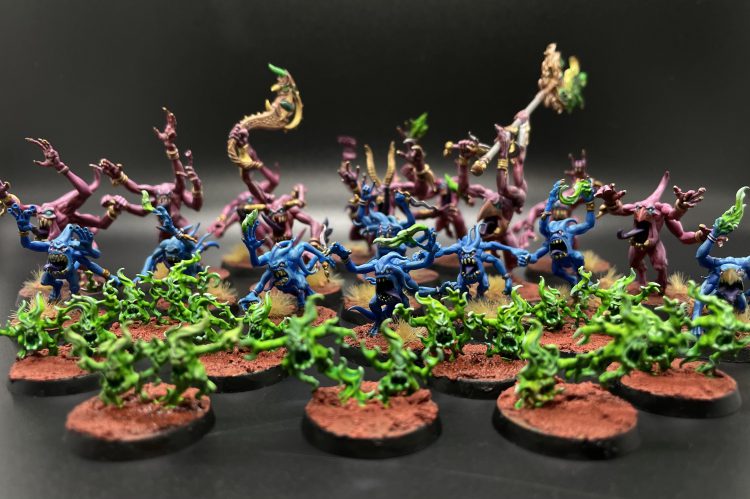
Army-wide Rules
Daemonic Invulnerability
Let’s talk about the most widely discussed new rule: Daemonic Invulnerability.
Daemons no longer have invuln saves on any of their datasheets. Instead, they just have Armour Saves (called Daemonic Saves, or DSv). Each DSv will list a melee save and ranged save, such a DSv 6+/3+ for Pink Horrors. The catch? The saving throws can never be modified in a positive or negative way. This means Daemons don’t care about AP, but they also don’t care about cover. They’re going to roll the save that’s on their datasheet–just like the Dark Gods intended.
This mechanic has existed in Age Of Sigmar for a long time as the Nighthaunt (if you’re unfamiliar with AoS, think of them as ghosts) faction rule. Sigmar is a fantastic game with an amazing community, and I’m a big fan of 40K experimenting with new mechanics. Let’s all take a deep breath and play some games before going crazy over this rule. The vast, vast, vast majority of the time, this will be functionally identical to an invuln save. The only exception will be that ignores-invuln weapons like Hammerheads won’t ignore DSvs.
What’s interesting is that almost all of the Daemonic Saves are worse vs melee than range. This is very fluffy–Daemons are more vulnerable in melee, where the raw emotions and rage of their opponent have a greater effect on the Daemons–and creates some interesting counterplay.
Malefic Weapons
Much like Orks got “Dakka” weapons codified into their codex, Daemons get their own unique weapon keyword: Malefic Weapons. Each Malefic Weapon will have a number (i.e. Malefic 3), and you can make that number (in this case 3) additional attacks with that weapon. Importantly, you can’t make your default attacks with a Malefic Weapon. If a unit has 4 Attacks base, a weapon, and a Malefic 3 weapon, every time they fight they will make 4 attacks with the first weapon and 3 attacks with the Malefic weapon.
What’s interesting about Malefic Weapons is that they are never affected by abilities that would add to, or subtract from, their weapon characteristics in any way. This means you can’t get extra attacks from them, and how they interact with some other abilities that affect the characteristics of attacks is a bit nebulous.
Manifestation
Mike P: Bringing back some of the flavor from previous editions, almost every single Daemons unit can now deepstrike anywhere 9” from opponents for free. That would be a nice buff by itself, but that’s not where the fun ends. Certain units (like Skarbrand, the Infernal Enrapturess, Masters Of Possession, etc) have the Warp Locus keyword. If a Daemon unit deepstrikes wholly within 6” of a Warp Locus unit, it can come down 6” away instead of 9” away from enemy units. This is a massive increase to their likelihood of making the charge. Daemonic Manifestations get even stronger and scarier as the opponent gets closer to your deployment zone. If you come down in outside of your opponent’s deployment zone and not wholly within your own deployment zone (so basically in the mid-field), you can set up your unit a number of inches away from an enemy unit equal to it’s Leadership. Is your opponent screening you with some Leadership 5 Termagant? Enjoy coming down only 5” away from them. And if your opponent dares to enter your deployment zone, true horror awaits them. You can set up units a mere 3” from opposing units if they are wholly within your deployment zone. This is an incredibly powerful mechanic in many matchups, and one that will reward a skilled Daemons player with easier mission play and better tools for attacking enemy units.
Monofaction Rule: Warp Storms
Like every other faction, Chaos Daemons get a monofaction rule to entice you to play with an army of just warp-spawned terrors. If every unit from your army (excluding Agents of Chaos and Unaligned units) has the LEGIONES DAEMONICA keyword, then you get to make a Warp Storm roll at the start of each battle round. When you do this, you roll eight D6, and for each 4+ you get a Warp Storm point. Unused points are lost at the end of each battle round (unless you have an ability that lets you retain them). Once you generate these points, you can spend them during the round to generate different effects. These abilities cost between 2 and 5 points each, though most cost 2 or 3. There are 8 undivided effects, and three each for each of the four Chaos Gods – you can only get those if you have a detachment dedicated to that god, and they only affect units of that god.
TheChirurgeon: On the whole, these abilities feel a bit undertuned. They’re hamstrung by the fact that rolling five or more 4+ results in a given turn is very difficult, and while that seems like a good reason to push you into taking more warlord traits to retain them, as we’ll see there’s no Stratagem to get additional warlord traits. The net result is that you can mostly just count on 2-3 points per turn to work with, and that makes this whole thing a little too unpredictable to be solid.
Undivided Effects
The biggest of these effects is also the only 5-point effect in the book: Dark Invigoration is used in the Morale phase to allow each of your Daemons units to heal a model D3 wounds unless the entire unit has models with a Wounds characteristic of 1, in which case you get D3 models back. That’s pretty good as an army-wide effect, and probably the strongest effect in the bunch (though note a unit can only get back models once per turn). Primeval Terror (3 points) gives your daemons an extra -1 Ld boost on their Daemonic Terror auras, which is great for reducing your manifestation range and causing morale failures. This can combo with Music of the Warp (2 points) to increase the range of your terror ability by 6” if your unit has an instrument. The most frequently useful of these are probably going to be Otherworldly Tread (2 points), which lets your units ignore movement and advance/charge roll modifiers in the movement or charge phases (pick one), and Descending Shadow (3 points), which gives your units -1 to be hit if they’re more than 12” away in the shooting phase.
Khorne
For Khorne the big one you’re going to aim for is Fury of Khorne (4 points), which gives your Khorne models +1 attack for a fight phase. It’s by far the stand-out ability of the three, and the only other useful option is Overwhelming Rage (4 points), which prevents enemy units from falling back on a 4+, but isn’t super reliable.
Nurgle
On the Nurgle side of things, Swarming Insects (4 points) gives your Nurgle units +1 to hit in the Fight phase, and that’s going to be your go-to, though Plague of Rust (2 points) can be helpful on your Soul Grinders, as it gives your Nurgle Vehicle units +1 AP when making melee attacks against enemy vehicles.
Tzeentch
Tzeentch gives you several good options to choose from, and probably has the strongest set of warp storm effects, though Slaanesh gives it a run. Deluge of Fire (4 points) gives your units +1 to hit in shooting that won’t affect your flamers, but will be useful for Soul Grinders, Exalted Flamers, and Horrors. Sorcerous Winds (3 points) gives your units +1 to their Psychic Tests and allows you to get some crazy totals with your Lords of Change, while Rampant Mutation lets you do extra mortal wounds on 6s to wound in melee, to a maximum of 3 mortal wounds per enemy unit per phase. It’s probably the weakest of the bunch, but still has uses.
Slaanesh
Finally we come to the Prince of Pleasure, who gets some truly solid effects. Mesmerizing Dance (4 points) gives all your Slaanesh units Fight first, and is just really good, while Lightning Speed (3 points) gives your Slaanesh units +1 to Advance and Charge rolls, and at 3 points is just super-dependable. It’s absolutely going to be a cornerstone of your strategy. Finally Dark Hallucinations gives your army a 12” aura that can prevent enemies from doing actions if you can beat their Ld on a 2D6. Plus each time you do, they take D3 mortal wounds.
Mike P: Army-wide -1 to hit from Descending Shadow is the standout to me. I’m also very excited to force your opponent pass a 4+ rolloff to fall back from every Khorne Daemon unit in your army, but the combined WSP 4 cost and 4+ rolloff make this very unreliable. Look for situations where you can have multiple Khorne units tag a single enemy unit to make protecting your units from shooting more reliable.
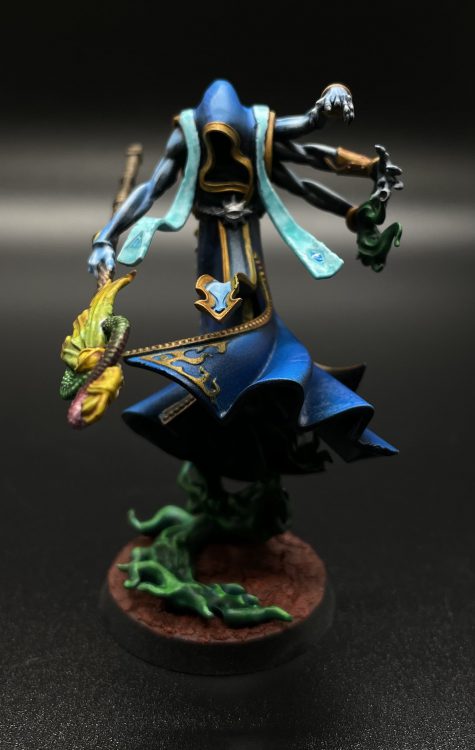
Secondary Objectives
Mike P: Chaos Daemons are the only 9th Edition codex to not include faction-specific secondaries. This ties in with the decision made in Nephilim to draw faction secondaries from the Matched Play mission pack instead of the actual codices. The lack of Secondaries in the Daemons codex strongly hints that this decision is here to stay. Even though the Daemons secondaries aren’t drawn from this codex, the launch of the new codex is a great time to discuss them.
The standout secondary is Reality Rebels. This secondary gives you 1VP at the end of your turn for every table quarter with more Daemons units wholly within it than enemy units, and an additional 1VP for having 1 unit wholly within 6” of the center of the table. This secondary plays similarly to Herd The Prey and Purge The Vermin, generating easy points all your game unless your opponent is extremely active and rushes straight towards you to deny it. Your opponent sending units towards your half of the board is something Daemons are generally very okay with. You will take this in almost every single game, and will consistently score 10-15 VP.
Up next we have two decent but flawed choices. In Shadow Operations, we have Despoilers Of Reality. This secondary rewards you with 4VP for performing actions on different objectives you control outside of your deployment zone. Because it’s not completed until your next Command Phase (or end of game), units that start this action will always be vulnerable. The upside is that you can have unlimited units start this action at the same time. If you suspect you’re going to table them and are playing a mission like Tide Of Conviction, this isn’t too bad. Realistically, just take Raise Banners and save yourself the headache.
The most interesting choice is Nourished By Terror. Reality Rebels is a near auto-take, and Despoilers Of Reality will almost never be taken. Nourished By Terror is going to be very matchup dependent, but has lots of upside. Your score 1VP for every model that flees, and have a chance to gain 1VP every time an enemy unit is destroyed if you roll 2D6 over their Leadership. With Daemons gaining a universal Leadership debuff and having additional ways to debuff Leadership further, you’re going to take this secondary more often than you think.
In terms of generic secondaries, Raise Banners, Psychic Interrogation, Warp Ritual, Grind Them Down, and killing secondaries are likely to all be reasonable choices for Daemons players.
Personally, I feel I’m going to take Reality Rebels/Raise Banners/Psychic Interrogation almost every single game, be satisfied with scoring 30-35 combined on those secondaries, and focus on crushing their Primary score.
TheChirurgeon: Ultimately I feel like the list is a bit dire – Reality Rebels is decent, but the other two options are mediocre at best and the updated book doesn’t give you many cheap options for doing actions – furies are no more and that makes Retrieving Nephilim data a lot worse, while sitting on objectives is harder with more expensive – yet still fragile – troops. I think that, similar to Chaos Space Marines, if Daemons do well post-codex it will be in spite of, and not because of, their secondaries.
Subfactions
Daemons don’t really have subfactions, but units do have a dedication to one of the four chaos gods. Each god has their own section in the rules (called a Book of something), with their units and abilities and stratagems broken out separately. Sadly, there are no longer bonuses for having an entire army or detachment dedicated to the same Chaos God outside of Warp Storm effects – no more Loci, unfortunately.

Khorne: The Book of Blood
TheChirurgeon: As a subfaction of Chaos Daemons, Khorne has always been disadvantged by virtue of not having access to psychic powers. When you combine that with daemons’ natural lack of shooting, it combines to make an army that’s pretty one-dimensional as a standalone force. The question has always been as a result: Can the God of War’s melee prowess make up for his lack of other tricks?
Units-wise, there’s nothing new for Khorne, though the unit datasheets have been updated to reflect how generally killy 9th edition has gotten. Pretty much every Khorne Daemon gets a 4+ DSv against ranged attacks, and many get a 5+ against melee attacks.
HQ
Bloodthirsters have gotten a major improvement here, and like other greater daemons are now sitting on more wounds – 20, to be exact. They’ve been condensed down to a single datasheet (finally), and now have S8, T8, and 8 attacks to work with on the battlefield, though their Movement, WS, and Attacks all degrade as they take wounds. The Axe of Khorne option now has a dual profile, doing either S+4, AP-4 D6 damage attacks or doubling your attacks at S:User, AP-3, 1 damage. The Great axe basically doubles this output, to Sx2 and D3+3 damage on the big swings and 2 damage on the little swings. That’s an interesting trade-off, given that your ranged weapon options aren’t bad – the Bloodflail has 12” range and does a single Sx2 AP-4 3D3-damage attack with damage spillover, and it’s probably the most interesting of the three off-hand options. As leaders, they give nearby Khorne CORE units re-rolls to hit of 1 and at the end of every fight phase on a 2+ you deal D3 mortal wounds to one enemy unit in Engagement range, which is a powerful ability for finishing off opponents.
Skarbrand is also back, with 22 wounds and increasing attacks as he takes damage. He comes with essentially a great axe weapon-wise, can’t be affected by psychic powers, and comes with a 6” aura that gives all models +1 attack, has them auto-pass morale tests, and be unable to fall back if they can’t roll under their unit’s Ld on 3D6. Like all of the named greater daemons, Skarbrand also has the WARP LOCUS keyword, allowing you to teleport daemons in near him.
Khorne daemons have a variety of herald options, each of which clock in with extra strength and toughness over a standard bloodletter. Standard heralds give friendly Khorne CORE units within 6” the ability to re-roll 1s to wound (making them a good compliment to thirsters), plus friendly Bloodletter CORE units within 9” the ability to auto-wound on 6s to hit. Skulltaker trades this latter ability for a +1 to hit on nearby bloodletter units. He’s very nasty in his own right – he re-rolls hits and wounds against enemy character units and his weapon, the Slayer Sword, is a S6 AP-3 3 damage weapon that ignores invulnerable saves. You’re gonna want him in a Khorne list, is what I’m saying.
Karanak is also back, and he’s mostly interesting as a cheap source of two denial attempts and giving re-roll 1s to wound to flesh hounds.
Exalted Bloodthirsters
If you’re planning to go mono-Khorne you’re gonna want some exalted Bloodthirsters. There are three options here, and the best of them and the one you probably want first is Indomitable Onslaught (40), which caps the number of wounds you can lose in a phase at 8. It’s not exactly C’Tan-level good, but it means you can’t be bracketed in the first shooting phase, and it is possible to regain some lost wounds with warp storm effects. After that, Master of the Blood Tithe give syou +1 Strength and Attack when charging/charged/intervening, and Rage Unchained makes you count as double your wounds for which profile to use.
Troops
You’ve just got Bloodletters. And as we’ll see for every other daemons troop choice, these come in units of exactly 10 models now, for a cost of 130 points. The Bloodreaper, Icon, and Instrument are all free. These guys are better than they were – now they come with S5, T4, 2 attacks base, and hellblades are 2 damage all the time – but they’ve still only got one wound, making them very much glass cannons on the table. Their daemonic save is 5+/4+ so they’re not quite as vulnerable to being shot off the table as they were, but at 1 wound you still want to keep them hidden.
Elites
Bloodcrushers have a better save than their footbound counterparts – 4+/4+ – and 4 wounds apiece, plus 3 attacks with their own hellblades and most importantly, they’re now Toughness 5. Their Juggernauts now have AP-2 horns that are Malefic 4 and hit at S7 on the charge. At 45 points per model, they’re a bit much for a unit with no shooting, but their ability to move 10” could make them a solid option for bullying units off objectives.
Fast Attack
Flesh Hounds. They’re faster now – 12” movement – and they come with S5 and 3 attacks base. Each unit can get one deny attempt, but the kicker here is that every time the unit charges or makes a Heroic Intervention, it gets +1 to its damage, turning its fangs into AP-2, 2 damage. The question is whether you want these guys at 19 points per model (T4, 2W, 5+/4+ DSv), or Bloodcrushers.
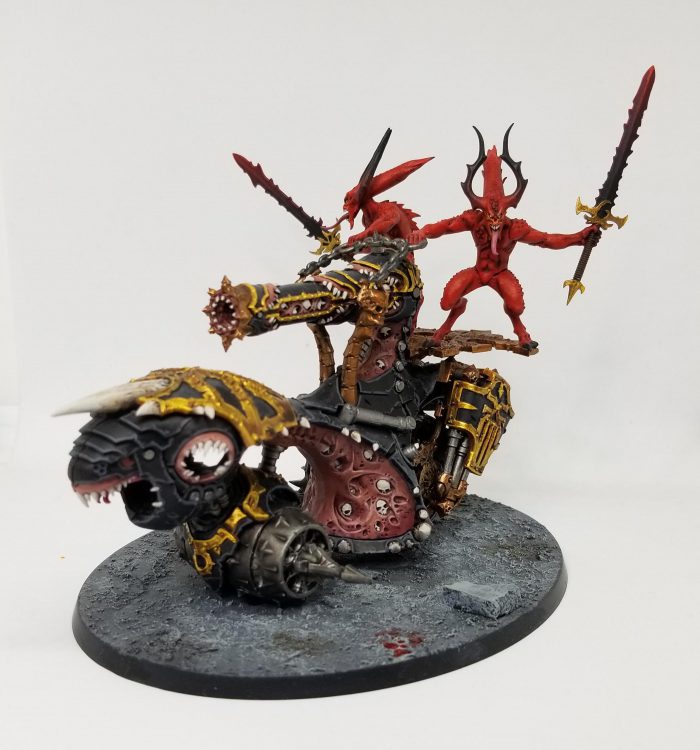
Heavy Support
The Skull Cannon actually has a lot going for it this time around – it’s faster (8” movement), stronger in melee (S6), has more wounds (9), and a 4+/4+ DSv. The big thing now is that its gun is actually pretty decent – it’s a 48” range Heavy D3+3 S8, AP-2 2-damage Blast weapon that enemy units don’t get cover benefits against, making it a bit more solid against marines trying to take light cover benefits to negate AP-2 shooting. It’s not amazing, but given you’re going to get at least 4 shots off per volley, you can do a surprising amount of damage with it.
Fortifications
There’s one fortification here – the Skull Altar. It’s a WARP LOCUS, and it gives -2 to Psychic tests to units within 18”. It’s still weird in that you can embark a single herald in it, in which case it gains the herald’s auras. While you’ve got a guy in it, it – the building – can attempt an action, going from your Movement to your Charge phase. When you finish you roll a D6 for every Khorne daemon unit within 12” of this model and also in engagement range of an enemy and for each 4+ you get a Warp Storm point. That is a hilariously large amount of work for a chance at 1-2 points. The potential good news is you can deep strike this using the manifestation rules, then use its WARP LOCUS ability to gate in a bunch of other daemons. It’s not a great unit otherwise.
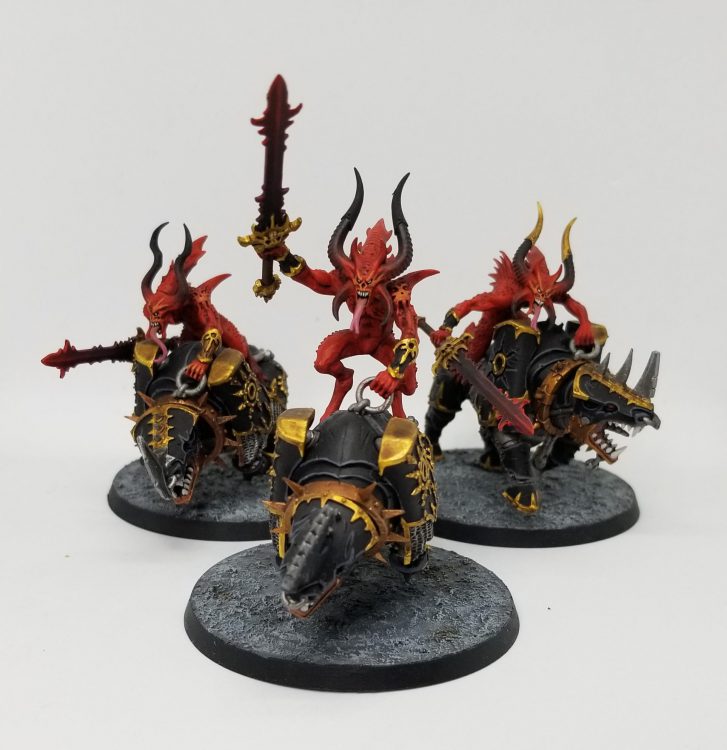
Stratagems
Mike P: There are six Stratagems for Khorne daemons where other gods got 8, and Khorne daemons particularly feel the inability to buy a second Warlord Trait.
- Frenetic Bloodlust (1 or 2 CP): Giving you the option to either make a Normal Move with a Bloodletter/Bloodcrusher unit or a pile-in at the start of any Fight phase, the threat of this stratagem will be a core part of smart Khorne gameplay. The implications for getting onto objectives, projecting threat, or getting to move in the Fight phase before the opponent are powerful.
- Relics of the Brass Citadel (1CP): Generic “buy a relic” stratagem for Khorne Characters, with the usual limit of usable once/twice/thrice depending on battle size.
- Glorious Decapitation (2CP): After one of your Characters kills one of their Characters in melee, your Character gains a 6” aura of “Khorne units generate a Mortal Wound on a 6 to Wound”. This is wonderful from a flavour perspective, and the effect is powerful from a gameplay perspective. In many matchups this may happen on too late a turn to make a real impact, but it will feel amazing when you’re able to proc it early during the game.
- Contempt for Sorcery (1CP): It’s a generic “deny a psychic power on a 4+” stratagem, but comes with an additional rider that you deny on a 3+ if they cast within 12” of any Flesh Hounds. These stratagems are always valuable, and the fact that Flesh Hounds improve the dice roll is fun and fluffy.
- Brass Stampede (1CP): This stratagem is unfortunately a shell of its former self. You roll a dice for every model in a Bloodcrusher or Vehicle unit that ended a charge within Engagement Range of an enemy unit. For each 6+ you do d3 MW. Vehicles add 3 to the roll, and do 3+d3 MW if they roll an unmodified 6+. The section about Bloodcrushers being able to declare new charge targets and charge again has been removed. Relying on rolling 6’s with a very small pool of dice is likely to end in disappointment.
- Banner Of Blood (1CP): Use this stratagem when an Icon unit (so Bloodletters and Bloodcrushers) declares a charge, and roll 3d6 (drop the lowest) instead of 2d6 on your charge. Combined with the ways that Daemons have to come in closer than 9” from deepstrike, this will make your deepstrike charges very reliable. Good clean fun.
Warlord Traits
TheChirurgeon: There are six Khorne Warlord Traits, but Heralds only have access to the first three. Aspect of Death gives enemy units within 6” -1 to their Ld and Attrition tests, Brazen Hide gives the Warlord a 5+ feel no pain (and is a solid pick for Thirsters), and Devastating Blow gives you the real fire, making it so your opponent can’t use rules to ignore wounds from your Warlord’s melee attacks. On the back half of the traits, Glory of Battle gives your Warlord +1 attack and an extra 1 or two if there are 6+ or 11+ enemy models within 3”, Immense Power gives the Warlord +1 to wound rolls in melee, and Rage Incarnate is the other strong candidate here, giving you +1 to advance and charge rolls, plus +1 to charge rolls for friendly Khorne CORE units making charges against units the Warlord is within Engagement range of. There are easily three great options here and having to choose only one of them is criminal.
Relics
There are six Khornate Relics here, and two of them are essentially bloodthirster-only. The Armour of Scorn is a thirster-only pick but a solid one, giving you +1 to saves against damage 1 attacks and a 4+ feel no pain against mortal wounds in the Psychic phase. The better option on an Indomitable Onslaught (8-wound cap) thirster however is probably the Blood-Drinker Talisman, which lets you regain one lost wound for every 5+ you roll for each model you kill in the fight phase, to a max of 6 regained wounds. A’rgath, King of Blades upgrades a weapon to have +1 damage and ignore modifiers to hit and wound rolls, while Skullreaver replaces an Axe of Khorne with one that becomes Sx2 Damage D3+3 against vehicles.
Finally, pour one out for The Crimson Crown, previously Mike P’s favorite relic, as it no longer gives you exploding hits but now lets you retain 2 unspent Warp Storm points at the end of a round if you destroyed any enemy models with the bearer. This is terrible.
Tzeentch: The Book of Change
TheChirurgeon: Tzeentch Daemons were on top for a while there in early 9th edition, with the exalted Lord of Change ruling the roost as a truly problem unit, with a 3+ invulnerable save. The good news for Tzeentch players – and bad news for everyone else – is that pretty much every Tzeentch Daemon now just has a 3+ daemon save against ranged attacks, making them an absolute nightmare to shoot off the table – you won’t even need an Impossible Robe!
HQ
Let’s start with the Dirty Bird. At 300 points, he costs about the same as he used to, only now he’s got 20 wounds and a 5+/3+ daemon save (so keep him out of melee). He comes with a staff (S6, AP-2, 3 damage) and for ten more points each you can give him a sword (S7, Ap-3, 3 damage, Malefic 3) and rod (ranged attack). The Lord of Change also has an aura to re-roll hit rolls of 1 for CORE Tzeentch daemon units but what you’re really here for are the psychic powers – the big bird gets +1 to cast all the time, or +2 if he has 10+ wounds, and he can attempt 3 and deny 2 powers per turn. Pretty good, and with support from the Warp Storm Effects and the Warlord Traits, you can get that to +4, which can help get off those 12-cast Infernal Gateways.
As a special character option, you’ve got Kairos, who comes with a couple of extra wounds, a 2D3-damage staff, and the WARP LOCUS keyword. Kairos has the standard aura but has two new abilities – One Head Looks Forward lets him add the current round number to his Psychic tests, while One Head Looks Back gives you a free “Agents of Vect” ability, increasing the cost of an opponent’s Stratagem by 1 after use (except the CP re-roll). Kairos gets 3 casts and 3 denies and while his one head looks forward ability is neat, ultimately I think he’s not quite as good as just taking another exalted Lord of Change.
Next come the Heralds, and there are quite a few options here. They all have a re-roll 1s to wound aura for Tzeentch CORE units, and the unnamed ones get a 6s to hit autowound aura. The Changeling here returns with a 5+/3+ daemon save but no longer has the ability to mimic a unit’s toughness for a round of melee, though you can still mimic their weapon and WS/S/A characteristics. Still, that and a cast aren’t bad for a 100 point price tag.
Exalted Lords of Change
If you’re taking a Lord of Change – and they’re a strong stand-out unit in this new book – consider giving it either Architect of Deception (-1 to be hit with ranged attacks), or Master Mutator, which has you roll a D6 for each any unit that took mortal wounds from a power manifested by the model and on a 2+ they take one more. This doesn’t seem like a lot but tacking an extra wound onto Infernal Gateway can be pretty nasty. The final ability is Nexus of Fate, which nets you extra CP in the Command phase on a 4+ and isn’t worth it.

Troops
Horrors got perhaps the biggest makeover in the whole book. Like other lesser daemons they now only come in squads of 10, and you have two unit options – pink and blue. Neither is a psyker; those days are over. Instead both have Coruscating Flames – an 18” Assault 2 S+1 AP-1, 1 damage gun. Pink Horrors are notable because of their 6+/3+ save and the fact that when they die you roll and on a 4+ you can replace them with 2 Blue Horrors, and those can then split into Brimstone horrors.
Blue Horrors might have been a sneaky amazing unit for the army but they can’t do actions and don’t have ObSec; in fact a pink horror unit that only has blue/brimstone horrors left can’t do actions and loses ObSec as well. That’s a shame, because Blue Horrors would have immediately become the army’s cheapest action/objective option and a must-take in many lists. So I get why they didn’t do it but man is it rough having your cheapest objective holder units be 130-point 1W models.
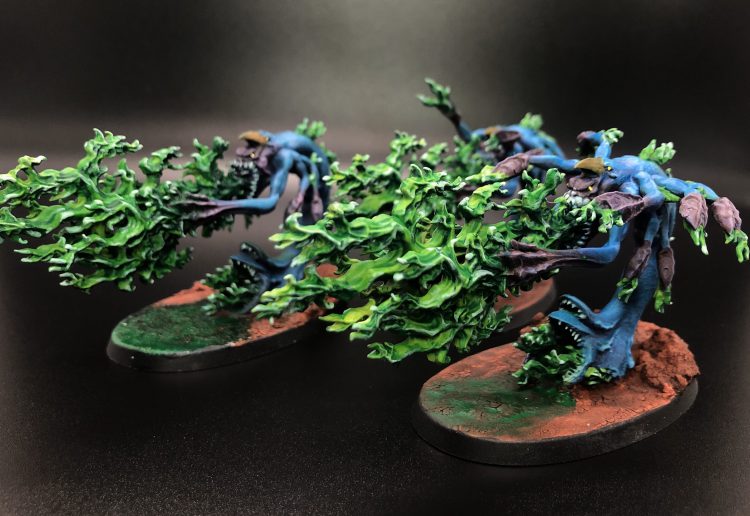
Elites
If Horrors are a bit disappointing, Flamers make up a lot of lost ground. They got a huge buff from their old incarnations, and how they’re S5 with 3 wounds apiece and a 6+/3+ DSv. Most importantly, their Flickering Flames are now Assault D6+3, S5 AP-2 weapons that can put out an insane amount of damage. At 25 points per model, they’re probably the biggest steal of the codex, and manifesting/deep striking in a unit of 6 to do an average of 39 hits is going to hurt a lot of units. The Exalted Flamer’s also in here for heavier ranged damage, and its Blue fire attack is now Assault 3 S9 AP-4, flat 3 damage, giving it a solid boost. The big reason you might take one however is its Blazing Warpfire aura, which improves the Strength of nearby Flamer units by 1, getting you to 2+ to wound against T3 models.
Fast Attack
Tzeentch offers a single Fast Attack choice, and that’s Screamers. Like many of the non-Troops units, Screamers got an extra wound, and like other Tzeentch daemons they’re rocking a 6+/3+ DSv. Their big upgrade is the Riders of the Immaterial Winds ability – now any time you’d Advance them, you can instead just pick them up and drop them back down anywhere on the table more than 9” from an enemy model. This can be handy for scoring something like Engage on All Fronts or Behind Enemy Lines but as Beasts Screamers lack the ability to do action secondaries and dropping a melee unit down 9”+ away with no way to improve your charge isn’t a great idea most of the time. They kept Slashing Dive, and now it does mortals to units you pass over on a 4+ instead of a 6+. This can be a deceptively good way to target characters if you have a unit of 6 and the right positioning.
Heavy Support
On the Heavy Support side we have the Burning Chariot, a faster, 9-wound version of the Exalted Flamer being pulled by Screamers. The Screamers give it a Malefic 6 S6 AP-3 2 damage attack, which is pretty dang good. Give them a Horror Infestation to give nearby Psykers -1 to their tests.
Stratagems
Mike P: There are 8 Stratagems for Daemons of Tzeentch, including Relics Of The Impossible Fortress (1CP), the generic “buy a relic” stratagem for Tzeentch Characters, with the usual limit of usable once/twice/thrice depending on battle size.
- Flames Of Mutation (1CP): At the end of the Fight phase, roll a dice for each model in a Horror unit destroyed that phase. An enemy unit within Engagement Range suffers 1MW for every roll of a 6. This seems decent at a glance, but remember that this doesn’t work if the Horror unit is destroyed. Then remember how easy it is for 10 T3 bodies with a 6+ save to get one-shotted by any melee unit in the game.
- Magical Boon (1CP): One Tzeentch Psyker can manifest one additional power that psychic phase. Always useful to have.
- Blasted Standard (1CP): Pick a Horror unit at the start of your psychic phase, and each time a Tzeentch Psyker manifests a power on an unmodified 9+, the closest visible enemy unit suffers 1MW. Fun and flavorful, throwing some extra MW downfield is never a bad thing.
- Warp Jaws (1CP): Add +1 to Wound rolls for Screamers, or the Screamer attacks of a chariot. You’ll likely use this several times a game if running Screamer-heavy lists.
- Warp Portal (1 or 2 CP): Now we’re talking! Pick up a Legiones Daemonica Tzeentch Character instead of making a Normal Move and place them anywhere on the board 9” away from enemy units (this costs 1CP if done to a Herald, 2CP otherwise). Teleporting a Lord of Change to control a flank or get angles for psychic powers is valuable, but realistically isn’t that strong because Lords of Change are very vulnerable in melee. But you know who is a Legiones Daemonica Tzeentch Character? Be’lakor.
- Minions Of Magic (1CP): Horrors gain bonus AP on 6’s to wound in range. While not a bad effect, Horror units don’t have the volume of firepower to make this stratagem really worth it.
- Burning Warpfire (1 or 2 CP): When shooting a unit of 11+ models, Flamers make the maximum number of flamer shots instead of rolling 3+d6. This is a very strong anti-horde stratagem, held back by the fact even traditional horde factions like Ork, Tyranids, and Guard aren’t running many horde units these days.
Warlord Traits
TheChirurgeon: Again we have 6 traits, and you can only ever have one of them in your army, which borders on being a hate crime. I cannot stress enough that all of these range from pretty good to amazing.
Heralds can only take the first three of these. Born of Sorcery gives you +1 to your Psychic Tests and is just incredibly good when put on a Lord Of Change. Incorporeal Form is also amazing, giving opponents -1 to wound rolls against the Warlord. Fractal Mind lets your Warlord perform a psychic action and still cast one power. Warp Tether gives your Warlord WARP LOCUS (!!) and lets friendly Tzeentch units within 12” re-roll Morale tests. Lorekeeper of Tzeentch adds 6” to the range of your Psychic powers, and Tyrant of the Warp prevents you from ever suffering Perils and gives you a 5+ feel no pain against mortal wounds. They’re all solid but for my money I’m probably taking Born of Sorcery unless I’ve got insane plans for a Warp Locus Warlord.
Relics
I was really hoping there’d be a relic that gives you a +1 to your casts to make for the hilariously broken +5 to casts option, but what we’re left with isn’t bad. The Endless Grimoire gives your Psyker an action they can do in the Shooting phase that finishes in your next command phase and gives them an extra power they know. The Impossible Robe returns, now turning one failed save per phase of your choice for your Warlord to Damage 0 (so you can’t bait this out with weak shooting first). The Everstsave makes your Witchfire casts of 9+ undeniable. The Warpfire Blade gives your weapon +1 damage and makes unmodified wound rolls of 6 do an extra mortal, while Soulbane upgrades a rod of Sorcery to be 3 damage and AP-2. Finally there’s the Soul-Eater Stave, which lets you regain lost wounds on a 4+ each time you kill a model with mortal wounds in the Psychic phase. It’s my second favorite of the bunch, behind the Impossible Robe that’s going to remain a must-take on a Lord of Change.
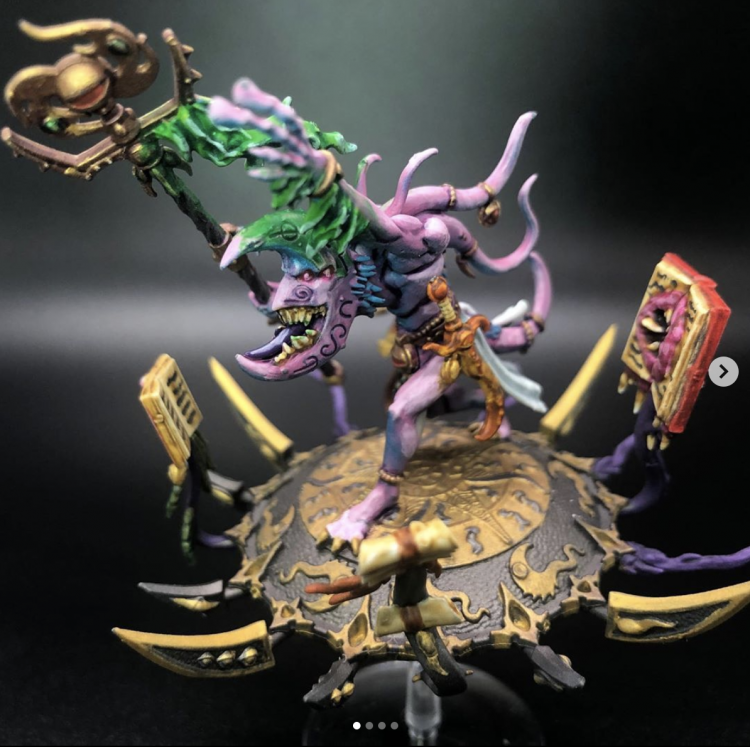
Psychic Powers: The Pandaemonic Discipline
After a ho-hum display of psychic might in Codex: Daemons, Tzeentch is back, baby! Some of these are good enough to make the Thousand Sons jealous. There are several effects here but the lack of shooting in your army likely means you’re going to prioritize mortal wound powers over buffs and debuffs.
- Boon of Change (WC 6) – Pick a friendly Tzeentch Daemon unit within 18” and roll a D3 (if you scored a 9+, you get to pick instead). Based on what you roll, the unit gets a bonus until your next psychic phase. On a 1 they get +2” movement, on a 2 they get +1 Strength, and on a 3 they get +1 Toughness. All of these are useful though the real money is probably giving Flamers +1S to get them to S7 with an Exalted Flamer/Chariot around.
- Bolt of Change (WC 7) – Pick a visible enemy unit within 18” and roll 9D6. For every 5+, that unit takes a mortal wound. For each model destroyed, that unit takes an additional mortal wound (up to 3). This is just straight up a better version of the Thousand Sons spell and worth taking. It’s going to get you 3-4 mortal wounds on average and lets you target enemy units.
- Gaze of Fate (WC 7) – You can retain 2 unspent Warp Storm points. Meh; you aren’t gonna take this.
- Treason of Tzeentch (WC 7) – Pick a visible enemy unit within 18”. Until your next Psychic phase, that enemy unit can’t be affected by enemy aura abilities. And this went from being one of the game’s coolest powers to being relatively lame. It’s a fine effect, I guess. It’ll be useful against some of the heavy-hitting midtable units that can be buffed by multiple auras but at the moment I’m struggling to think about what those would actually be.
- Infernal Flames (WC 7) – Buffs a friendly CORE Tzeentch unit within 18”. Until your next psychic phase, they get +1 to wound with ranged attacks. Again, this is going to do work on Flamers, where you can combine it with Strength boosts to trivially get to 3+ or 2+ to wound against tougher targets.
- Infernal Gateway (WC 8) – The closest visible enemy unit within 18” and each other enemy unit within 3” of that unit takes D3 mortal wounds. If you pull a 12+ with this, every affected unit takes 3 mortal wounds instead. This is where you want to stack Warm Strom effects with Born of Sorcery and either Kairos or a Lord of Change to hit a +4 on your casts. Being able to smash out 3MW to each target by rolling an 8+ is just stupid good. I don’t see how you take a Lord of Change and don’t end up with this power.
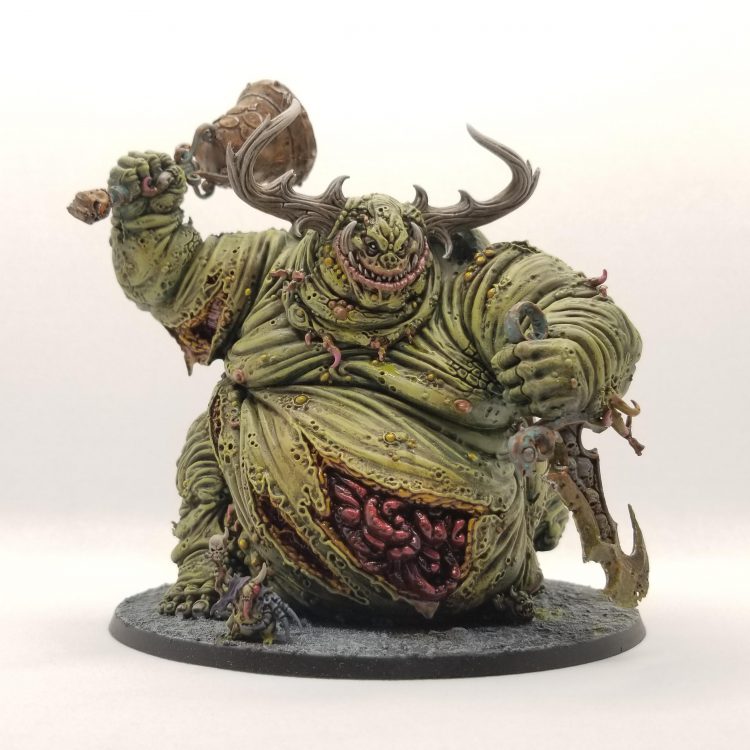
Nurgle: The Book of Contagion
TheChirurgeon: Hello friend, have you heard the good word of Grandpa Nurgle? You might have, given how strong Plaguebearers were for a while there in 8th (pre-points hike), or how insanely good Beasts of Nurgle and Nurglings were in early 9th edition (again, pre-points hikes). Well, now that we’ve got a clean(?) slate it’s time to take another look at the gross lads.
HQ
There’s a bit more to cover here than in some of the other sections, but let’s start with The Great Unclean One, who’s now bigger and grosser than ever, clocking in at T9, a 5+/4+ DSv, and 22 wounds – a massive upgrade from his previous T7, 18-wound statline that made him the only greater daemon you could see through Obscuring terrain. He’s also a little faster than before, with a degrading Movement characteristic that goes 7”/6”/5” instead of 7/5/3, and he’s more deadly, with the ability to do sweeping blows with his Bilesword (now the default weapon you’ll want) and his flail is now Assault D6+3. He gets two casts and one deny per turn and if you give him the biteblade he can take a mortal wound in order to get +1 to any given cast before making the roll. The bell is also still an option, though now it only brings back dead PLAGUEBEARERS CORE models within 12”, but the effect is guaranteed and INFANTRY units get back D3 models. Finally there’s one other addition, which is Putrid Vomit – a 12” S5 AP-2 1-damage flamer.
In a similar fashion, Rotigus is back with the same statline, only he’s got a much nastier flamer (S6, 2D6, AP-3), and the WARP LOCUS keyword. His big selling point here is the Deluge of Nurgle ability, which makes it so every time you roll a 7+ resolving a psychic power, the closest enemy unit within 24” takes D3 mortal wounds. That’s extremely good, though there’s no way I can find to boost his psychic tests. Both Rotigus and Great Unclean Ones have an aura to re-roll 1s to hit.
Next comes the cavalcade of Nurgle Heralds. As with other heralds, these give nearby NURGLE CORE units re-rolls of 1 to wound. The Poxbringer is the basic variety, and his bonuses are that he’s a PSYKER (1 cast), and he can buff a Plaguebearers Core unit in the Command phase to get +1 damage on unmodified wound rolls of 6. The Spoilpox Scrivener can give a Plaguebearers Core unit +1 to hit and ObSec (or double model counts if it already had ObSec). And The Sloppity Bilepiper can give a single Nurglings, Plaguebearers Core, or GUO unit +1 to move, Advance, and Charge, and can debuff one enemy unit within 12” – if you roll above their Ld on D6, you can either turn off ObSec for them or take away their ability to do actions.
Finally there are the special Heralds. Epidemius is no longer a boon to Death Guard Daemon Engines; instead his Tally of Pestilence just gets you an extra Warp Storm point at the start of each battle round if you killed 7+ enemy models with Nurgle Daemons in the prior round. Horticulous Slimux buffs Beasts and Plague Drones rather than Plaguebearers, buffing one unit with the ability to re-roll charges and get +1 to hit, and having the ability to seed area terrain, causing enemy units to treat it as Difficult Ground and take mortals every time they move in it. This is a pretty solid ability, though with only a 5” movement characteristic and the need to be wholly within, it’s unlikely to be something you put on more than one terrain feature per game.
Exalted Great Unclean Ones
You’re only ever taking one of these, and that’s Revoltingly Resilient (+30 points), which gives your Great Unclean One -1 damage on incoming attacks. The other two are whatever – Bountiful Gifts lets you retain 2 warp storm points per round, and Hideous Visage gives enemy units within 6” -1 Ld and -1 to combat attrition.
Troops
The two standard options are back here and Plaguebearers are the stand-outs of the lesser daemon group by being the only models with 2 wounds. At T5 and a 5+/4+ DSv, they’re easily the most resilient of the bunch, and they’re OK, if not amazing in combat thanks go having 2 attacks with an AP-2 sword that autowounds on 6s to hit. On the other hand you’ve got Nurglings, which are a little tougher – T3 now and they have an innate -1 to be hit – and they can still forward deploy, but they don’t have ObSec, can’t do actions (still a Swarm), and now they can’t fill any compulsory battlefield role slots in a Detachment. This basically makes them a 1-of at best as a way to score early CP or sit on an forward objective they can’t hold. The only good news is they’ve gone back down to 20 points per model.

Elites
Hoo boy. Beasts of Nurgle are back and boy are they nasty now. Beasts got a massive overhaul, going to S6, T6, and 7 wounds each with a 5+/4+ DSv, plus at the end of each phase, any wounded model in the unit heals back up to full health. They’re much, much tougher than they were and if that weren’t enough they’re much more deadly now too, with flat 6 attacks each at S6, AP-2, 2 damage that do 2 mortal wounds instead every time you roll a 6 to wound. Oh yeah and to top it all off, they can still Intervene up to 6” and they can explode now when they die, only damaging enemy units. They can’t trap you in melee any more – well at least not for free (see Stratagems), but the tradeoff is well worth it. They come in squads of 1-3 models now and clock in at 80 points per, making them pricey but incredibly nasty midtable objective holders.
Fast Attack
Plague Drones started to see play later in 9th and they’re back and better here as well. S5, T6 with 5 wounds apiece, these flying terrors come with Death’s Heads, plagueswords, and can choose between foul mouthparts (S5, AP-2, 2 damage, Malefic 2) or a Prehensile Probiscis (S4, Ap-2, 1 damage, Malefic 4). Either way they’re a nasty, quick unit that’s going to be much harder to remove than some of the game’s other fast units.
Fortifications
Finally we have the plague tree and this thing is going to be the unassuming monster that powers a lot of janky shit. At 75 points, the Gnarlmaw can be set up anywhere on the battlefield during deployment that’s more than 9” away from enemy models or their DZ (and 3” from other terrain, but if you need to you can deep strike manifest it), plus it gives friendly non-Monster/Vehicle Nurgle Daemons within 6” -1 to be hit and it can bring back dead Plaguebearers every turn. But the real value is that WARP LOCUS keyword, which means you can basically stuff a whole army into that tree and either forward deploy it or deep strike it on turn 2 and pile a whole army out of it.
Stratagems
Nurgle Daemons have 8 Stratagems, including one for getting an extra Relic. Again, no Stratagem for a second Warlord Trait.
- Revolting Constitution (1 CP/2 CP) is used to give Transhuman Physiology (wound rolls of 1-3 always fail) to a unit of Plaguebearers, which is helpful for keeping your Drones on the table especially.
- Chortling Murrain (1 CP) is used in the Shooting phase to do mortal wounds to enemy units near a Sloppity Bilepiper – up to 6 – based on your ability to roll above the Toughness characteristic of models in the unit. This is one of the few remaining areas of synergy with Death Guard, and is pretty fun.
- Pestilent Inspiration (1 CP) gives a Nurgle psyker all of the powers in the discipline for a turn. Interesting as an option, because there are more than 2 good ones, but not sure how often you’ll use it.
- Slime Trail (1 CP) can be used by a unit of Beasts or Horticulous in your opponent’s Movement phase to trap enemy units in Engagement range on a 4+, keeping around a key ability from Beasts in the older book.’
- Swarming Flies (2 CP) lets you give a Nurgle daemon unit -1 to be hit in the opponent’s Shooting or Fight phase, making this a pricey but extremely good Strat that you’re going to use often. The one odd thing about this is that there’s no timing text on it, which makes things more confusing than they need to be.
- Crushing Bulk (1 CP) works in the Charge phase on a GUO, Beasts, or Plague Drones unit and has you roll a D6 for each model in the charging unit, adding 3 if your charger is a Great Unclean One. Roll a 6+ and you score D3 mortals, roll a 9 and you get D3+3. It’s a big ask on what may only be 3 models, but on a GUO getting it off half the time isn’t too bad.
- Plague Banner (1 CP) charges up your Nurgle Icon units, having them do 1 mortal wound instead of their normal damage every time they roll a 6 to wound, to a max of 6 per phase.
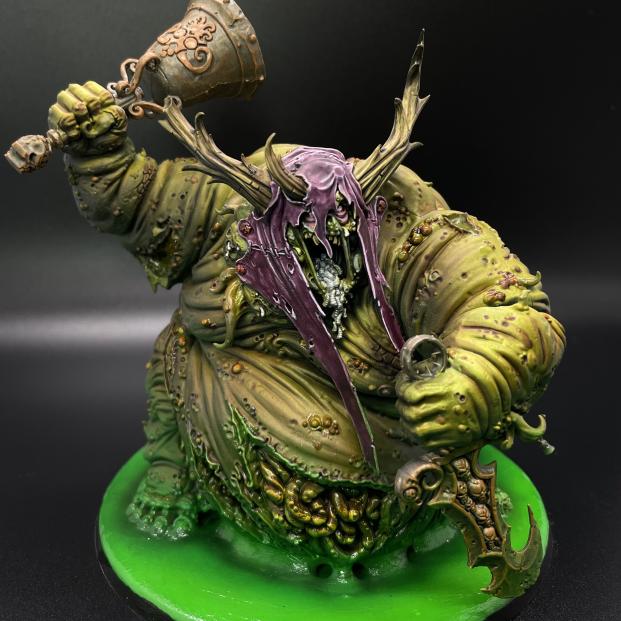
Warlord Traits
Six traits, you only get one in your army, and Heralds can only take the first three. Heaving Mass gives you +2 wounds, which is better on smaller models than a GUO. Acidic Ichor does mortal wound to enemies each time you take a wound in melee (4+, up to 6 per phase). The big winner of the bunch is Virulent Touch, which automatically turns all your hits into wounds with melee attacks. Plague Fly Hive Gives you a 6” aura that gives enemies -1 to hit you in melee and prevents units from doing actions. Overflowing Fecundity gives you permanent Transhuman, and is only really going to be relevant on the Heralds, who can’t take it. And Pestilent Miasma triggers at the start of the Fight phase, doing mortal wounds to each enemy in unit in Engagement Range- 1 mw for each 2-5, D3 for each 6.
In my mind the best of these is Virulent Touch, which you can put on a Great Unclean One armed with a sword and give the sword the Corruption Relic for the damage boost to create a very nasty melee threat.
Relics
Nurgle daemons have access to six relics. The Horn of Nurgle’s Rot can bring back dead Plaguebearers every time a nearby unit kills enemy models in melee (up to 3 per turn), turning them into semi-poxwalkers. The Entropic Knell is a powerful relic option that lets you turn off a nearby enemy’s aura abilities every Command phase and halve the number of models they count as, rounding up, for holding objectives. If you want more casting power, the Tome of a Thousand Poxes gives you an extra known power and on a 7+ your casts can’t be denied. Effluvior is an upgrade on a plague flail with damage 3 that rolls over – pretty neat. The Endless Gift heals its bearer for a number of wounds equal the round number at the start of your command phase, and can be pretty nasty if you keep the model around.
My favorite of the bunch is Corruption, which upgrades a weapon with +1 damage and makes it so enemy units can’t ignore wounds done by the weapon. This is great on a GUO with Virulent Touch, giving you an incredibly nasty melee monster who can easily take out threats like Abaddon on the charge.
Psychic Powers
Nurgle Daemons have access to the Warprot discipline, where the spell names are all familiar but the powers have changed. Generally speaking, they’re all much better.
- Stream fo Corruption (WC 6) does D3 mortal wounds to the closest visible enemy unit within 12” and D3+2 if the unit has 11+ models.
- Fleshy Abundance (WC 7) gives a friendly unit +1 Toughness.
- Nurgle’s Rot (WC 7) has you roll over the Toughness of a nearby unit on 2D6. Beat their Toughness and they take D3 mortal wounds, or D6 if you roll double or more than their toughness.
- Shrivelling Pox (WC 6) is essentially unchanged: It gives an enemy unit -1 Toughness to a visible enemy within 18”. This is another one that has great synergy with the Death Guard, since being able to drop an enemy unit’s Toughness by 2 can let you get away with some nasty attacks.
- Virulent Blessing (WC 6) gives a friendly Nurgle Daemons CORE unit within 18” +1 to its damage. Shame you can’t put this on a GUO but it’s plenty nasty on Plague Drones and Plaguebearers and an incredibly strong boost for taking on tougher targets.
- Malodorous Pall (WC 8) has you pick an visible enemy within 18” and they lose ObSec and can’t do actions. This is another really strong ability, and probably a power you’re going to want in your army if you’re taking Nurgle. It’s particularly good if your plan for holding the middle is to use Beasts of Nurgle, which are otherwise not ObSec either.
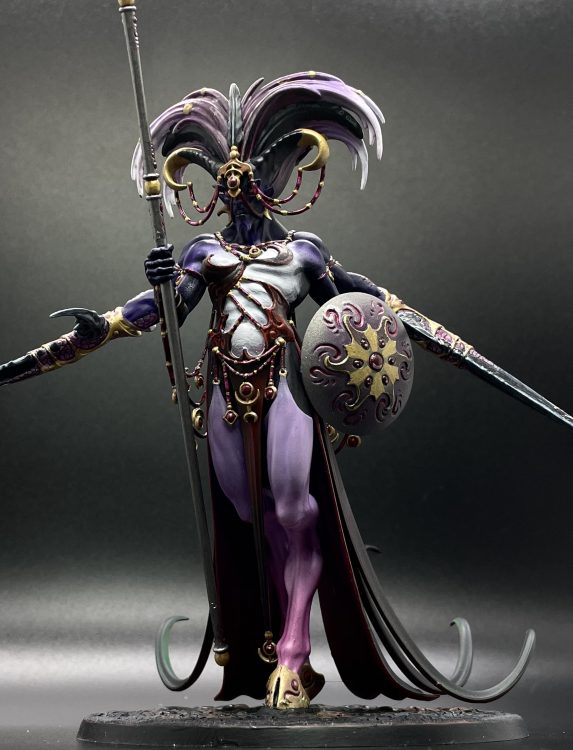
Slaanesh: The Book of Excess
Mike P: As befits Slaanesh, the Book Of Excess part of the Daemons codex is filled with exciting highs and disappointing lows.
More than any other God, on the surface Slaanesh Daemons suffer the most from the removal of detachment loci. Losing the extra threat range from being able to advance and change seems disappointing at first. The upside is that some extra movement has been baked into almost every datasheet to compensate. For example, Daemonettes went from 7” to 10” movement, an increase of 3”. Considering an average advance roll is 3-4”, they’re not really slower than they were before. Keepers now move 16”, up from 14”. And our Soul Grinders are faster than ever (which is still not saying much, but it’s something!). Slaanesh was also the melee army that had almost no bonuses to their charges from deepstrike, so all of our new closer deepstrike mechanics will give us tons of new options to explore.
Overall Slaanesh is in a strong spot, and both mono-Slaanesh and Undivided players are going to have lots of fun with Slaanesh units. My one caveat would be that a few of the flavorful units with amazing sculpts that were added when the Slaanesh line was updated–particularly the Contorted Epitome and Syll’Esske–have lost most of the flavor and power from their datasheets.
HQ
Slaanesh players are absolutely overloaded with quality HQ choices, so let’s dive right in.
Keepers Of Secrets will be a very strong choice for Slaanesh players to build around. They are no longer the clear HQ choice for Slaanesh players, but that is largely because most other HQs are now worth considering, rather than a nerf to Keepers themselves. Their weakness was always to ranged weapons, and they’ve become more durable there. Their -1 to Hit in melee changed to -1 to Hit against all attacks to compensate for the fact they no longer benefit from Obscuring terrain. If you’re still concerned about your Keeper Of Secrets being shot off the board, you can always deepstrike it for free using the new Manifestation rules. They now degrade in Weapon Skill as they take damage, but the upside is that their claws are a Malefic 4 weapon now and no longer degrade in attacks. It’s a mix of buffs and nerfs overall, but ultimately I think Slaanesh players will still really enjoy running Keepers in the new codex.
Shalaxi Helbane continues to be a very interesting alternative/supplement to a Keeper Of Secrets, and arguments could be made for both depending on your list. The main benefit of Shalaxi is that she has the crucial Warp Locus keyword. Shalaxi manifesting another Keeper Of Secrets next to her is a hilarious image, and a play that I imagine Slaanesh players will use often.
Once we move past the Greater Daemons, Slaanesh players have to choose from a massive pool of HQ options. To start with a common rule, Heralds’ (now generally called Tormentbringers) buffs are now a reroll 1’s to Wound aura for Core units instead of a +1 Strength aura. This is a fair sidegrade. Tormentbringers can also give a Core unit +1 to hit, meaning Tormentbringers and Daemonettes, Seekers, and Fiends will be a strong pairing.
The Tormentbringers on Seeker and Hellflayer Chariots are really solid options that start to shine when combined with certain Warlord Traits and relics. The Tormentbringer on Exalted Seeker Chariot is a decent datasheet, but still suffers from being 10+ Wounds so it doesn’t get Look Out, Sir.
The Infernal Enrapturess now has a key role as the only Slaanesh Warp Locus character that can be protected by Look Out Sir. It can move up safely early before dropping in a Keeper Of Secrets 6” away from the enemy the following turn. It’s harp has also become a stronger weapon, and it regen some nearby models over the course of the game. Previously just a beautiful model, the Infernal Enrapturess is now a great piece to build a strategy around. The Masque also has gained some additional flavor, choosing a debuff to give an enemy unit each Fight phase.
In disappointing news, the Contorted Epitome has lost the ability to prevent nearby units from falling back. It also lost the bonus to cast that made it the most reliable source of Slaanesh psychic powers. It gained another debuff for enemy units in the command phase and received a fairly large points drop, but it’s one of the few losers in the Slaanesh roster. Syll’Esske similarly lost some flavor, losing the powerful ability to activate twice in exchange for adding some Malefic attacks and operating in a single activation. The loss of the +1 Strength aura has hit Syll’Esske hard, as they went from S8 to S7 on their main axe. Still coming in at 200 points, Syll’Esske is hard to justify in any Slaanesh lists. At least the model remains beautiful!
Exalted Keepers Of Secrets
Frankly all three Exalted options are excellent. If you want to run 3 Keepers, you won’t go wrong buying different Exalted options for all 3. The standout is Diaphanous Panoply, which makes your Keeper -1 to Wound at range. This compensates for Keepers being only T7, and makes them both more resistant to anti-tank and very durable against high volumes of S4-S6 attacks. Epicurean Of Agonies and Insatiable Onslaught providing melee buffs and movement buffs respectively mean you have a nice array of options to choose from when exalting your Keepers. Coming in between 20-35 points and not requiring any CP, you’re likely always going to exalt any Keepers you bring.
Troops
Daemonettes are a unit you’re going to build many of your lists around, and frankly I think they’re one of the standout units in the entire book. And no, I’m not just saying that because I have 90 Daemonettes I’ve lovingly built and painted (although that certainly doesn’t hurt). They’re pricey on the surface at 120 points for 10 T3 wounds, but they’re a bit faster and hit much harder in melee. The offensive buffs available to them from various HQs, stratagems, and psychic powers can transform a single unit of Daemonettes into an absolute blender. A single unit of Daemonettes with 1CP for Rapturous Standard and a cast of Hysterical Frenzy averages 57 S4/AP2/1D hits. Now that’s what I call a good time.
Elites
Fiends have a new role now. They have lost the ability to prevent units from falling back, but have gained damage output and durability while getting a points drop. They’re no longer going to be a tech choice to keep other units you actually care about from being shot. Now Fiends are going to be your shock troops that hit the flanks hard and chew through the first line of enemy defenses. The fact that they also have the Core keyword will make them a strong choice for many Slaanesh lists.
Fast Attack
Seekers are the ideal unit for people who prefer their Daemonettes to move 16” instead of 10”. With the Daemonette and Core keywords, you can put some strong buffs (like a 5+++ Feel-No-Pain from Delightful Agonies) on them.
You have the choice between Seeker Chariots and Hellflayer Chariots as the other fast attack options, and neither is bad. They’re outclassed by the Exalted Seeker Chariot because of its much larger pool of Wounds, but they’re decent budget options that contribute reasonable offensive and defensive output.
Heavy Support
Slaanesh has only one real option for ranged damage output: Soul Grinders. Slaanesh lists are very vulnerable to aircraft, outside of hand-delivering love taps with Be’lakor or a Daemon Prince. While they don’t gain any raw offensive or defensive buffs, gaining 4” of Movement is huge on such an unwieldy unit. You can definitely run 1 or 2 Soul Grinders in your Slaanesh lists and feel fine with that.
The more traditional Heavy Support option for Slaanesh players, the Exalted Seeker Chariot, is maybe my favorite datasheet in the new codex a real sleeper hit. It does almost no damage output into anything with a 3+ Armour Save or Toughness 5 and above, and this is totally okay. It’s there to race into their lines with 12 T5 Wounds and disrupt their gameplan while your real damage dealers get into place. Every Slaanesh list I write is starting with 2 or 3 of these.
Stratagems
The Slaanesh stratagems all have decent albeit situational effects, and are priced to use.
- Exquisite Gifts (1CP): Generic “buy a relic” stratagem for Slaanesh Characters, with the usual limit of usable once/twice/thrice depending on battle size.
- Thirst For Souls (1CP): Full hit and wound rerolls in melee vs an Aeldari unit. FINALLY! It has been painful facing Elves players all edition who had a version of this stratagem against SLAANESH units. Emperor’s Children players still take a lopsided beating since they have no equivalent stratagem, but now Slaanesh Daemons players can return the favor.
- Razor Sharp Caress (1CP): Daemonette units gain +1AP on 6’s to wound. A small but non-negligible effect, given the weight of dice that Daemonettes can throw around now.
- The Endless Dance (1CP): Daemonette units can pile-in and consolidate 6”. Extra fight phase movement is always useful.
- Impossible Elegance (1CP): Choose one of your Characters, and hit rolls of 1-3 in melee fail. A powerful tool to have when facing Custodes or other Characters.
- Melodic Delirium (1CP): A Fiend unit gains a 12” aura of -2 to cast. Would have much preferred to just see this on their datasheet, instead of being a stratagem.
- Race Through the Warp (1CP): One of your Chariots goes into Strategic Reserves. You’ll use this occasionally to score Behind Enemy Lines or position yourself to grab an objective late game.
- Rapturous Standard (1CP): An Icon unit gets full hit rerolls in melee. This is pure value.
Warlord Traits
The Warlord Traits for Slaanesh Characters are the weakest out of the four Gods, although there are still some decent choices. In a sense, that’s a good thing for Slaanesh players. It makes it less painful that you can’t buy additional Warlord Traits.
Your non-Keeper Of Secrets Characters can only choose from the first 3 options, and Keepers can choose from all 6. Warp Mists lets you retain two unspent Warp Storm points, a decent if boring effect. Fatal Caress let’s some of your Wound rolls ignore invuln saves. As Slaanesh units generally only have AP 0-3, this loses a lot of value in an Armour Of Contempt world. The Murderdance gives you +d3 Attacks when you charge. Quicksilver Duellist lets you reroll Hits against everyone, and Wounds against Characters. This is very solid on a Keeper Of Secrets. Savage Hedonist increases your Strength each battle round (to a maximum of +3). This seems underwhelming at first, but is the start of some very strong mounted Herald builds. Aura Of Bewitchment messes with enemy Actions. You can find something better than this.
Relics
Continuing the trend started with the Warlord Traits, the Slaanesh Relics are a rather mixed bag. Everyone’s favorite Forbidden Gem has returned in a redacted form. You select one nearby enemy unit in your Command Phase, and that unit loses all auras until your following Command Phase. It’s something.The Mark Of Excess gives you +1 Attack and an additional Attack every time you destroy a Character, Monster, or Vehicle unit. Soulstealer gives Daemon Princes or Keepers the ability to regenerate Wounds after killing models. The Slothful Claws increases the damage characteristic of Ravaging Claws or Snapping Claws by +1. Snapping Claws are Malefic Weapons and as such can never have their Characteristics modified, so I have to wonder whether this is a mistake or something that will be FAQ’d. Silverstrike gives enemies wounded by a Keeper Of Secrets a permanent melee debuff. Whip Of Agony lets your Keepers make 2 additional attacks with their whip, and let’s their whip auto-wound on a 4+ to Hit.
You’ll likely be buying multiple relics in every list, unless you choose detachment configurations that run you extremely low on CP from the start.
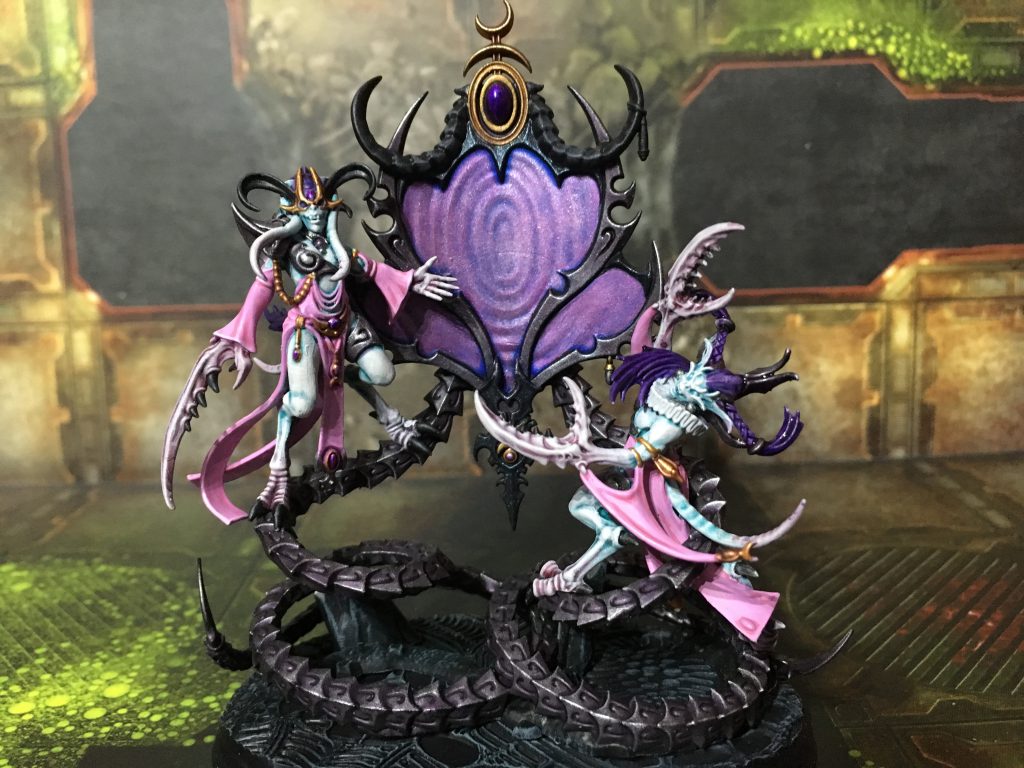
Psychic Powers
The Soulstain Discipline has a nice blend of damage output, debuffs to enemy units, and buffs to your own units. The only thing holding it back is the lack of bonuses to your casting rolls, and the relatively high WC values of some of the best spells.
- Phantasmagoria (WC6): Select an enemy unit and roll 6d6. Every 5+ is a Mortal Wound and -1 to their Leadership characteristic. This is a decent effect that combos well with…
- Cacophonic Choir (WC7): Roll 3d6, and do Mortal Wounds equal to the gap between the closest enemy unit’s Leadership and your 3d6 roll (to a maximum of 6 Mortal Wounds). Given that Daemons have several ways to debuff Leadership, this will be a decent tool to have access to.
- Symphony Of Pain (WC7): Select one visible enemy unit and subtract -1 from it’s Hit and Wound rolls in melee. Good, clean fun.
- Hysterical Frenzy (WC7): A Daemonette or Seeker unit gets +1 Attack and exploding 6’s to Hit. This turns any given Daemonette or Seeker unit into an outrageous dice factory. Good, dirty fun.
- Delightful Agonies (WC6): A Core unit gets a 5+++ Feel-No-Pain. It always felt unfair that the CSM version of Delightful Agonies gave a 5+++ Feel-No-Pain while the Daemon version gave a 6+++ Feel-No-Pain, so it’s a relief to see that this grave injustice against our Daemonic friends has been righted.
- Pavane Of Slaanesh (WC6): A classic “roll a dice for every model in an enemy unit” spell. It goes off on a 5+ instead of the usual 6+, but is capped at 6 mortal wounds. A perfectly fine damage dealing choice.
Chaos Undivided: The Book of the Warp
Mike P: While the Big 4 Gods get all the attention, many players enjoy playing their Daemons as a Chaos Undivided army. The codex includes a section focusing on the units who aren’t marked to one God by default, and provides updated rules for the Disciples Of Be’lakor Army of Renown.
While most rules for Disciples of Be’lakor require your entire army to be from that Army Of Renown, there is an exception for the psychic Noctic discipline. As long as your army includes Be’lakor, models in your army can be given powers from the Noctic Discipline. This is an incredibly powerful benefit to running Be’lakor, given that the most important powers have received updates to work on any Legiones Daemonica unit.
HQ
Be’lakor is BACK. “Back” is a bit of a misnomer considering he was one of the best units before this codex too, but seriously: Be’lakor is back.
Be’lakor is now a Supreme Commander, meaning he can fit into a Supreme Command detachment and open up HQ slots. He also has the Warp Locus keyword and every God keyword, meaning Daemons from any God can come in danger close near him. Unlocking access to the Noctic Discipline for other Psykers has some powerful implications that we will discuss in the Psychic Powers section below.
While his points cost has gone up and he no longer receives the benefit of Obscuring terrain at 20 Wounds, he received -1 Damage at range to help keep him on the table. The only disappointing–and I use this word very lightly–part of his datasheet is that his offense wasn’t buffed at all. His offensive stats are identical to his previous datasheet.
Daemon Princes are going to be a serious consideration for every God. They must choose an Allegiance to one of the 4 Gods, but receive a powerful benefit depending on which choice they make. For example, dedicating your Daemon Prince to Khorne gives you +2 Attacks and +1 Strength. That’s a seriously powerful melee buff.
Now that Greater Daemons can’t be Obscured, Daemon Princes play a key role as the most powerful melee option you can bring that can move up the board without being shot.
Heavy Support
Soul Grinders have received a huge glow-up in the new codex, going from a very cool looking joke to a legitimate consideration for competitive Daemons lists. Hitting on 3’s both in melee and at range, they bring a very nice mix of melee, shooting, and durability to any list.
Just like Daemon Princes, you have to choose a God Allegiance for your Soul Grinders, but receive powerful benefits for every choice. My favorite choice for a Soul Grinder’s allegiance is Nurgle, which brings your Soul Grinder up to Toughness 9. Slaanesh is another flexible choice, as adding 4” of Movement to a unit that moves 8”/6”/4” is a proportionally very large buff.
TheChirurgeon: I am so incredibly here for Soul Grinders. They’re going to be the perfect compliment to my Thousand Sons, who sometimes need good shooting support, sometimes need punching support, and as a result Soul Grinders fill a hole that War Dogs don’t fit quite as well. Tzeentch Soul Grinders may not get T9, but a 4+/4+ DSv is still pretty dang good.

Army of Renown: Disciples of Be’lakor
Mike P: Players that have previously played Disciples of Be’lakor will be very familiar with most of the rules in the updated Army Of Renown, as most of the key mechanics have remained. Maybe my favorite change in the codex is that Disciples Of Be’lakor are now a Faction keyword. Disciples Of Be’lakor players can still bring a House Korvax Superheavy Auxiliary (SHA) detachment. Now that Disciples Of Be’lakor is a faction keyword, your House Korvax SHA is free in terms of CP. The only downside is that you have to choose Blessing Of The Dark Master as the favour for your Knight if you choose it which is… absolutely fine, as Blessing Of The Dark Master is arguably the best choice in the entire codex.
All of the previous restrictions have returned. You still can’t run any Cult Marines, named Characters, or Daemon Engines. These are minor tradeoffs to make, as Disciples Of Be’lakor are still very strong.
Disciples Of Be’lakor armies can still use the Warp Storm system even if you bring Chaos Space Marines and a House Korvax SHA. You should note that Chaos Space Marines will still break access to Daemon secondaries if you include them in your Disciples Of Be’lakor army. I’m not sure whether this is intentional, but the rules are clear for now.
TheChirurgeon: Fun Fact: Nurglings get Objective Secured in a Disciples of Be’lakor army, making them substantially more useful. No such luck on Blue Horrors, though.
Overall the loss of any faction secondaries if you take Chaos Space Marines makes the Disciples of Be’lakor army kind of DOA competitively if you take marines, but it might still have play if you take Chaos Knights. It’s definitely a weird interaction and I agree I don’t think it’s intended.
Stratagems
Let’s discuss the Stratagems available to Disciples Of Be’lakor players. To those of you who’ve played the army previously, these will be familiar as they haven’t really changed.
- Shadow Pact (1 CP) lets you pick a Legion Disciples Infantry unit in the Command phase to get a pact bonus for a turn. This can be +1 Attacks, a 5+ invulnerable save, +1 Toughness, or +1” to movement and +1 to Advance and charge rolls. A fine way to get a quick buff on something like Possessed.
- Daemonic Boon (1 CP) is used at the start of the Fight phase when a non-Vehicle Legion Disciples unit within 6” of a Daemonic Disciples unit fights. It gets +1 Strength and hit rolls of 6 auto-wound. This is pretty nifty on Warp Talons and Raptors, though having to be close to a Daemons unit severely limits its utility.
- Legions of Shade (1 CP) is used at the start of your Movement or Charge phase to let a unit move horizontally through enemy models.
- Mortal Boon (2 CP) lets you auto-pass (with a 1) a Morale test for a daemons unit in the army, which can trigger some bonus effects.
- Draught of Terror (1 CP) is used in the Morale phase on a Daemons unit in your army to give it an Aura that heals and gives you back models every time an enemy model in range flees.
- Blessing of Be’lakor (2 CP) is the real money here, which lets you drop to 0 the damage of a single attack against which you failed a save. Very helpful for shrugging off Railguns and Dark Lances.
Psychic Powers
The Noctic Discipline adds some powerful mobility and debuffs to your Daemons army. Just a reminder that any of your Psykers can generate powers from this Discipline as long as Be’lakor is in your army. Let’s dive right in.
- Shrouded Step (WC6): You can pick up a Legiones Daemonica Infantry or Disciples Infantry unit, and place it down anywhere on the board more than 9” from enemy models. This will be a great option to deliver units like Flamers across the board turn one, pull units out of combat, score Engage On All Fronts or Reality Rebels, and just generally cause Chaos. This is a great tool to have.
- Wreathed In Shades (WC7): This prevents opponents from targeting a Legiones Daemonica or Disciples non-Monster or Vehicle unit unless it’s the closest unit, or the shooting unit is within 12”. Always useful, even if the high casting value makes it a bit unreliable.
- Pall Of Despair (WC7): This power returns unchanged, and gives you a choice of powerful debuff to apply if the opponent fails a 3d6 Leadership check.
- Voidslivers (WC5): Returning unchanged, Voidslivers is as useful as every other “draw a line to an enemy unit, and do 1MW to every enemy unit the line goes over” effect in the game. This is not a good thing.
- Penumbral Curse (WC7): This power returns unchanged, which is a bit surprising. It gives an enemy unit -1 to Wound in melee, which is nice. It also reduces the AP of that unit’s melee attacks by 1, which is basically useless. Daemon units don’t care about AP, and your Chaos Space Marine units get no benefit from this because they already have Armour Of Contempt.
- Betraying Shades (WC6): This damage power returns unchanged, and does some Mortal Wounds to multi-model enemy units with lots of attacks. Always a decent choice into units like Harlequin Troupes or Daemonettes.
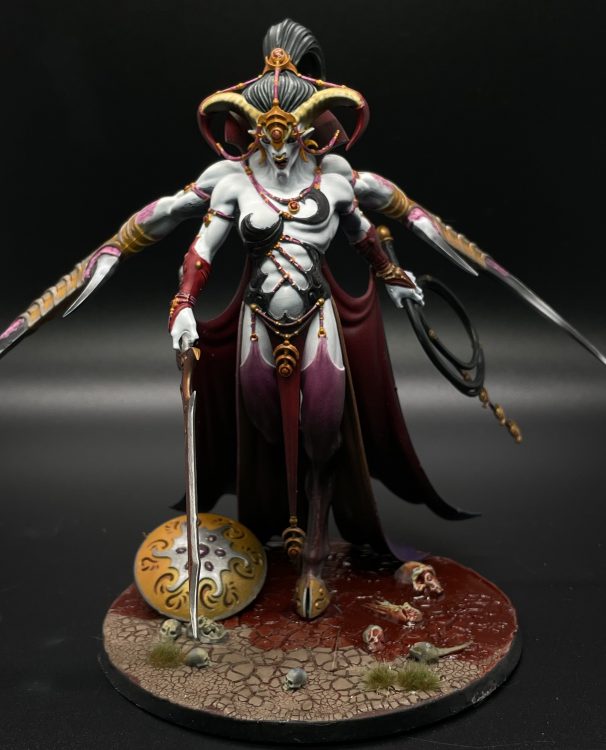
Some Lists
A review wouldn’t be complete without some lists. Here’s what we’re thinking.
Mike Pestilen’s Slaanesh Daemons War Crimes List
Mike’s Note: This list is best paired with “Look What You Made Me Do” playing in the background
- Supreme Command Detachment
-
-
- Be’lakor (420 Points): Warlord
-
- Slaanesh Daemons Battalion
-
-
- Keeper Of Secrets with Diaphanous Panoply (315 Points): Shield, Soulstealer (-1 CP)
- Keeper Of Secrets with Insatiable Onslaught (300 Points): Living Whip, Whip Of Agony (-1 CP)
- Shalaxi Helbane (300 Points): Whip, Quicksilver Duellist (-1 CP)
- 5 x 10 Daemonettes (120 Points): Icon, Instrument
- Seeker Chariot (65 Points)
-
- Total: 1995 Points, 3/6 CP
Step 1: Walk up to the table.
Step 2: Shake your opponent’s hand.
Step 3: Pick Reality Rebels/Banners/Psychic Interrogation as your secondaries.
Step 4: Apologize for what you are about to do.
Step 5: Commit war crimes for 5 turns.
Step 6: You don’t need any additional steps, but I included a 6th step because Slaanesh’s sacred number is 6. All hail the Dark Prince.
I don’t think lists like this will ultimately be the optimal way to run Daemons, but they bring lots of raw power and will be extremely powerful in some matchups and missions. Monster Mash is always a fun way to play when the datasheets make it possible. You have a variety of powerful debuffs you can apply to the enemy between the Noctic Discipline, Soulstain Discipline and the innate datasheets of your Keepers and Be’lakor. Now get out there and get your hands dirty.
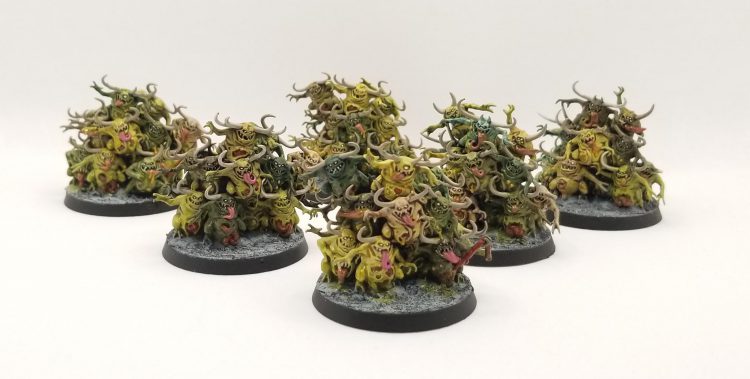
TheChirurgeon’s Making Soup
Ultimately I’m not as impressed with the mono-daemons army. I think the secondaries are a hurdle I don’t want to try to overcome. Even in that list above, I don’t particularly care for spending 240+ points on units that have to sit back and do banners. On the other hand, I like what the Soul Grinder brings to marine lists, specifically Thousand Sons and Death Guard. While War Dog Executioners give you amazing backfield shooting, in Thousand Sons I often need something that can counter-punch in melee, while in Death Guard I could do with more ranged shooting support that isn’t Plagueburst Crawlers, but is just as tough.
The problem I ran into as I was building these lists is that staying under 25% on power level is very, very difficult with two soul grinders, which run 10 PL each and 190 points. At least, in Thousand Sons it’s near impossible; Death Guard had a much easier time hitting higher point values. You might be just fine running a single Soul Grinder in Thousand Sons, but I’m not sure it’s worth it. Instead it might be worth putting together a Death Guard list, where the Soul Grinders also work well here as a replacement for Plageuburst Crawlers, which are very durable but overall less impressive on the table.
+++ Death Guard Parol Detachment +++
HQ: Malignant Plaguecaster
Troops: Plague Marines x6
Troops: Plague Marines x6
Troops: Plague Marines x6
EL: 5x Deathshrouds
EL: Tallyman
No Slot: Putrifier
FA: 2x Mephyitic Blight Haulers
FA: Bloat Drone w/Fleshmower
DT: Rhino
DT: Rhino
+++ Daemons Detachment (Nurgle) +++
HQ: Poxbringer
Troops: Plaguebearers
HS: Soul Grinder
HS: Soul Grinder
This Daemons Detachment is basically the cheapest possible option that can incorporate two Soul Grinders, and I like them here as a long-range support unit that can also get into combat perfectly reasonably. Here the Deathshroud occupy the middle the same way they always do while the Soul Grinders move along the outside and support the Plague Marines in Rhinos, most likely, or just offer ranged support. At T9 they’ll be a pain to shoot off the table. The Poxbringer here can also further help out by dropping the toughness on enemy units. I’d love to have Nurglings in here – as were in my initial list – but they can’t eat the compulsory choice slot, so it has to include Plaguebearers.
Note: The easiest way to boost your Power Level without increasing points is to add a 6th plague marine/rubric marine to a unit, which doubles the squad’s PL while only adding 21 points.
Final Thoughts
Mike P: The stratagems are the low point of the book. There’s certainly some valuable ones, but the lack of generic stratagems and each God being given only a single page of stratagems means mono-God players have a surprisingly small pool of stratagems. There’s also some minor issues with relics not working correctly, Disciples Of Be’lakor losing Daemon secondaries, and some units like the Contorted Epitome losing some flavor.
But on the whole? This codex brings many fun and powerful new rules, and as a Daemons player I can’t wait to get all my new lists on the table and experiment with everything in the codex. This codex is dropping during one of the most balanced overall metas we’ve seen in years, and this book certainly gives Daemon players a chance to compete.
And one last note–I can’t believe I’m actually excited to put my Bloodthirsters back on the table again. I want to dust off both of my Soul Grinders. My horde of Daemonettes can’t wait to dance and tear the enemy to shreds. Basically every single unit in this codex is viable, which will be one of the most satisfying aspects of the new book for hardcore Daemons players. No one is going to feel like “Ugh I chose the wrong God, guess I’ll have to wait for the next codex”. Now is our time to shine regardless of what units you like to run. Now get out there and despoil reality!
TheChirurgeon: I have mixed feelings about this book. There are some very powerful datasheets in here, and from a balance standpoint, the book feels pretty solid. I think it’s more of a B-Tier outing from Games Workshop power-level wise, and that’s a good thing overall. If there’s one thing I lament here, it’s that a lot of the weird, quirky rules that used to be in Chaos Daemons are just gone now, replaced with stuff that’s vaguely reminiscent of the older abilities but doesn’t quite capture the flavor.
Overall the new Daemons book feels like they’ve tried to shift the army from a horde to an elite army, but they forgot to give them multi-wound troops to actually make that viable. Right now the biggest challenge Daemons have is a lack of cheap objective holder/action doer units – it’s a real shame Furies were removed from the book because they’d have solved these problems very elegantly. As-is, I think Daemons have lots of strong individual datasheets but kind of ho-hum army rules that have to be overcome, and as a result they may lend themselves better to soup. Though while we’re on that note, I have to say, from working on lists I can tell you that the 25% PL restriction is a lot harder to work with than you think, and you will likely find it very difficult to fit in the daemons units you want. I don’t think it’s possible to do a double-soul grinder Thousand Sons list that’s worth playing, but I’m going to give it another shot at some point.
Also fun fact: Soul Grinders come on bases now. They’re huge. I think they’re the same ones they package with the Astreus.
Have any questions or feedback? Drop us a note in the comments below or email us at contact@goonhammer.com.
